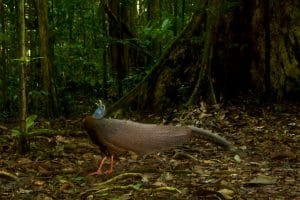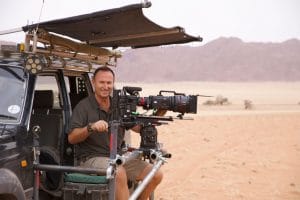
Catch the footage in episode 3 of The Mating Game at 8.05pm today via UnifiTV Channel 501 and Astro Channel 554.
Link: BBC Player | BBC Earth
ANIMALS are not likely to show up for a photocall at the set. It is the filming crew that has to be up and ready and most of all patiently wait for some hot action to film animal behaviour in their natural habitat – let alone, an animal-mating scene.
Every wildlife filmmaker knows it well. Filming in remote unforgiving terrain and having to contend with weather that may not be favourable, as well as engaging with animals that are shy and elusive is tricky business. And in situations like these, film directors do not get a second chance to call for a retake. A shot missed is a shot lost forever.
Beyond these challenges, the 271-member shooting crew of The Mating Game spent a total of 127 days in quarantine to comply with global Covid-19 public health precautions. The pandemic also caused the cancelling of 18 planned shoots that were slated for the five-episode documentary.

However, against all odds, The Mating Game scored an impressive tally, successfully filming 80 different species of big and small animals in 22 countries, spanning six continents. The making of The Mating Game clocked 1,194 days on location and successfully captured 83 different mating strategies that animals use in their quest to mate and multiply for their species’ survival. The crew also spent 150 days at sea accomplishing 500 hours of underwater diving.
The new landmark series narrated by Sir David Attenborough features animals in different terrains: Grasslands: ‘In Plain Sight’; Oceans: ‘Out of the Blue’; Jungles: ‘In the thick of it’; Freshwater: ‘Timing is everything’ and the last episode: ‘Against All Odds’.
In a nutshell, the various episodes present the weird and wonderful behaviours, tactics and strategies that animals use to find a mate. It is the story behind the most fascinating, hilarious and dramatic quests in the animal kingdom to find a mate and leaving a lasting legacy.
The queer and the wonderful
In the mating game, the shooting crew observed that for some species distance does not matter when it comes to finding a mate. As if taking a cue from the romantic one-liner of long-distant lovers, ‘distance gives us reason to love harder’ – these species are willing to overcome the challenges of a vast environment to get to their mate.

Other species find themselves pitched against their neighbours in mass mating aggregations – while some males try to impress their potential partners with romantic displays of dance and dynamics, like the great argus pheasant filmed in the Gunung Palung National Park in the Indonesian side of Borneo.
Yet still, there are those that build extraordinary love nests as if in a dowry-deal just to ‘prove their worth’. Compelling efforts from across the animal kingdom, often with unexpected outcomes, highlight just how unpredictable the mating game can be – as everything is not always as it seems, where illusion can often trump brute force, as the filmmakers noted.
Shooting in the African grasslands of Serengeti, they recorded the vicious and an unforgiving scramble for sex – where a violent game plays out among the plains zebras, where one jealous stallion defends his harem of mares in a herd of 30,000 strong. In South Africa, rains can trigger brutal clashes between bullfrogs in a royal-rumble style where the ‘last frog standing’ gets the bride.

The shooting crew also noted that chimpanzees are notorious for their brutality and violence, and for most of them, this is the simplest way to secure a mate. Dominant males can fight off rivals and impress the ladies in what their human cousins term as ‘the best man wins’. But for one younger male, the crew observed a forging of a long-lasting romantic relationship through care and attention which proved to be incredibly gainful for the handsome Romeo – perhaps the most eligible bachelor in the pack.
While some animals might prefer a more subtle approach to mating, one jungle creature has his compulsive and lustful desire to breed written all over his face. A mandrill, the largest and heaviest monkey in the world, wears his blue and red face like a badge of honour. Only the strongest male can wear such bright colours or facial make-up and hope that his face alone will be his fortune to win the lady and beat other rivals to the throne.
In Finland, a male ruff passes undetected from larger rivals by disguising himself in female plumage, the deceiving and cheeky cross-dresser that he is! And here comes the ‘cheating Santa’, where nursery web spiders in back gardens of the British countryside wrap fake presents to entice the female of their choice.
All said, one thing connects every species when it comes to the mating game – the intense drive to succeed at all costs. The mating game is all about the varied, hilarious, dramatic, fascinating and downright bizarre wooing tactics animals use to find a mate. It is the ultimate inside story of ‘bedroom scenes’ from the animal kingdom, brought into living rooms worldwide by BBC Earth, spelling what it takes to succeed at the mating game.
As the episode’s synopsis puts it: “Intimate details are captured in habitats from every corner of the globe – with each episode demonstrating how an environment shapes the mating game in the animal kingdom. The mating game in the wilds and in the deep blue oceans have evolved a unique and intricate set of rules for each player.”
Newer species and high tech cameras
Speaking to The Vibes from London via Zoom recently, the documentary’s series producer, Jeff Wilson, and Episode Three producer, Joe Loncraine, lent some fascinating insight – when asked how The Mating Game differs from a 1969 feature Sex and the Animals produced by Harold Hoffman – and the contribution of modern camera technology to the making of The Mating Game.
“I think the amazing thing about the mating game or any mating strategy in both, the scientific world and in natural history’s film-making world, there is a constant amount of learning that is still continuing,” said Wilson.
“We are always learning new things about the natural world and when we looked at the premise of the series for our content, we realised that there were almost too many new things going on in the natural world and there are animals that were not known to science then, as we know them today.
“We have a huge amount of revelation and knowledge on the mating strategies and behaviours of various species and the newly discovered ones as well, all of which gives us a great opportunity of what we can observe, shoot and bring to modern audiences,” added Wilson.
Wilson also pointed out that today’s modern camera technology is way ahead, of what filmmakers had in 1969.
“Let alone fifty years ago, camera technology is advancing tremendously every five years. We can capture things not only on much better high resolution, our lenses are much better, and we have more advanced macro lenses that allow us to zoom into the thick of action, while our camera track technology is close to being the ultimate with our underwater camera and accessories way too advanced.”

Wilson cited a scene where the crew managed to capture the courtship behaviour of humpback whales, referred to as a “heat run”, which involves a single female swimming at high speeds, with up to 30 male whales following her.
“The males are constantly ramming each other, slashing their tails, and using their huge pectoral fins to hit each other. The conclusion to these chases remains a complete mystery, with no one having ever seen humpbacks mate.
“We spent over a year designing a gyrostabilised underwater camera that could be fixed to the side of a boat and worked with whale researchers to get the camera right in the thick of the battle.
“Our camera successfully captured extraordinary images of a male and female humpback, with the male gently blowing bubbles underneath her, before swimming on top of her, and caressing the top of her head with his rostrum,” added Wilson.

When asked why Borneo’s great argus pheasant was specially selected to ‘star’ in The Mating Game from all the many other pheasant species in the world, Loncraine said the bird is most renowned among naturalists. It also played an important role in the development of Charles Darwin’s theories of evolution.
He said: “Despite its important place in zoological lore, the great argus pheasant’s courtship is poorly understood and had never been filmed in the wild due to their extremely reclusive nature.”
To drive home the importance of this, Sir David Attenborough himself actually said in a pre-recorded interview for this series: “I had tried multiple times to film the argus pheasant in my career and seeing the footage finally in The Mating Game is a major highlight of this documentary.”
Republished from The Vibes, October 17, 2021
















